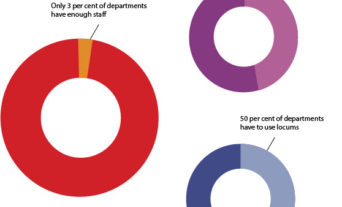Harnessing technology to reshape healthcare delivery, step change towards prevention and the need to exploit the big data promise are now recognised as the key pillars of transformative innovation in healthcare.1 Clinical biochemistry is well placed to underpin and lead delivery of these innovations: laboratories routinely detect or quantify diverse circulating targets (chemical compounds, nucleic acids, proteins and enzymes) to provide information used for the prevention, screening, diagnosis, treatment and management of diseases.
Capturing this data is key to characterising complex pathophysiological phenotypes and personalising diagnosis and treatment of patients. Retaining the ability of clinical biochemistry to adopt innovations and drive the translation of powerful multidiscipline methodologies and novel biomarker concepts into routine patient care across the whole of the NHS is of fundamental importance if precision medicine is to become the exemplar across the 21st century NHS.
Service transformation
NHS clinical biochemistry strives to deliver world-class diagnostic services while maximising cost efficiencies. Over the past 20 years, efficiency and savings appeared to be the main priority for services transformation; such drivers shaped the direction of organisational thinking and led to the proposed development of expanded pathology services to deliver further service optimisation. We contend that organisations should not limit their thinking to achieving efficiency savings through consolidation − with effective clinical leadership and staff engagement, more is possible. This strategic direction offers a unique opportunity to facilitate and lead innovation back into the operational planning of routine diagnostic services.
Service consolidation could provide the means for enabling resources to be reinvested to support the rapid adoption of innovative new technologies and new approaches to the delivery of pathology.
This ambition aligns with delivery of the new NHS long-term plan that places research translation and innovation as key enablers of improvement.2 This additional activity could be funded by investment of savings achieved by the transformation of services and quality improvements. Lord Carter’s report in 2008 clearly identifies that transformation of pathology service is necessary so that they can respond swiftly to the challenges presented by innovation (particularly from the genomic and data revolution), system reform across the NHS and reform of the workforce.3 Service consolidation could provide the means for enabling resources to be reinvested to support the rapid adoption of innovative new technologies and new approaches to the delivery of pathology. By contrast, when service consolidation attempts to ringfence services and therefore knowledge, this could lead to silos and frustrate attempts to integrate the full spectrum of diagnostic innovations into patient care.
Bringing innovation in operational planning could and should be a core aspiration of each pathology network development plan, especially when it is supported through effective engagement with NHS specialised services and the Academic Health Science Networks. For example, frontline diagnostic services can interact with Genomic Laboratory Hubs (GLHs) to embed relevant ‘molecular’ knowledge and methodologies into routine diagnostic laboratories where appropriate. This can maximise the benefits of new advances in molecular pathology and genomics. It will also deliver diagnostic tools and new concepts involving predictive risk algorithms for polygenic diseases that combine analysis of multisource phenotypic, genotypic and environmental data.
Furthermore, interaction of diagnostic laboratories with academic and industry experts in health data analytics can facilitate translation of recent advances in artificial intelligence (AI). An ambitious investment programme in resources, such as the UK Health Data Research Alliance4 to accelerate innovative use of data sciences in medicine and health, has already generated the necessary infrastructure to support this ambition. Integration with pathology providers, genomic medicine, academic institutions and industry is essential to establish appropriate governance around use of patients' genomic and phenotypic data for research and possible commercial exploitation. As those data will shape the future of precision diagnostics and drive the precision medicine agenda, it must be held close to the patient, likely in NHS Trusts, to ensure that data held is contemporary, thus avoiding the constant need to refresh and pull data sets.
Evolving technologies may lead to certain skill redundancy while new skills may be required to keep up with developments in the field. Innovation must be embraced to address emerging national healthcare challenges associated with increasing numbers of ageing patients with chronic diseases, such as dementia, mental health disorders and multimorbidities related to obesity, diabetes, cardiovascular disease and cancer.
Pathology networks and clinical biochemistry
In addition to developing infrastructure to meet the operational quality requirements, consolidated pathology networks and clinical biochemistry departments within it will need to integrate new technologies and prioritise the upskilling and training of staff to support a world-class evidence-based healthcare system at the forefront of clinical science and innovation. For example, cutting edge technological advances and innovation need to be brought back into the laboratories. Staff, who have been appropriately upskilled, will need to lead the implementation of new diagnostic technologies and concepts. This is crucial since the workforce of next generation laboratories will be required to operate and manage highly automated platforms that integrate complex chemistries for a wide array of tests with support from appropriate AI-based interpretative risk algorithms. Evolving technologies may lead to certain skill redundancy while new skills may be required to keep up with developments in the field.
Innovation must be embraced to address emerging national healthcare challenges associated with increasing numbers of ageing patients with chronic diseases, such as dementia, mental health disorders and multimorbidities related to obesity, diabetes, cardiovascular disease and cancer. These represent intriguing but challenging examples of common diseases that fit the gene x environment (lifestyle) interaction paradigm. It is expected that this will be addressed by diagnostic testing transformation based on –omics and protein-molecular fusion technologies and advances in pathology digitalisation and molecular imaging.
The case for stronger interaction between clinical biochemistry and genetics services is indeed compelling to ‘future-proof’ diagnostic services and maximise benefits of the investment to address increasing and changing demand, and meet patient and clinical expectations associated with personalised and preventative medicine.
Incorporating genomics testing into clinical biochemistry services Decoding the genome alone cannot fully explain polygenic disease phenotypes and frequent discrepancies between phenotype and genetic data do occur (see some examples below, in Box 1).
| Box 1: Examples of diagnostic and methodological challenging situations identifying the need for integrated approaches and knowledge between molecular/genomic and clinical biochemistry departments. | |
| Clinical challenges | Target of collaborative efforts |
| Investigation of hereditary haemochromatosis: Minimal risk genotypes (such as C282Y heterozygosity) associated with variable manifestations of disease and strong phenotype biochemistry data (raised transferrin saturation) in the absence of secondary causes | Combined efforts to characterise ‘phenotype and genetic risk modifiers’ (gene x gene x environment interactions |
| COPD and AAT deficiency: Pi Z individuals and severe AAT deficiency exhibit marked variability in lung (also liver) disease manifestations and severity | |
| Investigation of FH: addressing ‘genotype negative, phenotype positive’; discrepancies between presence of mutation and disease severity and use of polygenic LDL-c risk scores; presence of monogenic variants or polygenic FH may also guide cascade screening strategies |
Establish impact of environmental factors that modify CV risk phenotype in a way that is not captured by polygenic risk scores; need to establish standards and ensure that genetic risk score tests are performed and interpreted with the highest quality and in a way that is optimal for patient care |
| AAT: Alpha-1 antitrypsin; COPD: Chronic obstructive pulmonary disease; CV: Cardiovascular; FH: Familiar hypercholesterolaemia; LDL-c: Low-density lipoprotein cholesterol. | |
This complex relationship has been described by Dr J Stern, University of California, Davis, as ‘genetics loads the gun but the environment pulls the trigger’. Therefore, blood sciences and genetics together with healthcare data sciences need to establish a close and effective working dialogue to bridge diagnostic information gaps around the patients’ phenotype seen at the clinic. Optimising use of diagnostic methodologies and, ultimately, clinical data and pathways will become more urgent as rapid precision diagnosis and treatment becomes the decisive factor and clinical laboratory teams shift testing emphasis towards prevention and screening.
The challenge is how recent investment in genomic medicine can also catalyse transformation of diagnostic services and offer wider benefits across the NHS diagnostics asked to screen, diagnose and monitor an expanding range of common but heterogeneous diseases. Detection of genetic background and epigenetic clues will be important for managing and treating each patient individually. Appropriate testing protocols to investigate heterogeneous phenotypes employing sophisticated data approaches and algorithms will need to be designed. Spreading the benefits of genomic medicine across the NHS diagnostic networks will require the diffusion of molecular expertise across suitable pathology settings.
The case for stronger interaction between clinical biochemistry and genetics services is indeed compelling to ‘future-proof’ diagnostic services and maximise benefits of the investment to address increasing and changing demand, and meet patient and clinical expectations associated with personalised and preventative medicine.
Below we present some key opportunities and drivers for closer interaction. At the heart of the changes, there must be an understanding that to improve patient care we must innovate in service models, in training and development, in staff engagement and opportunities, and finally in the discovery of novel diagnostic tests, their development and application.
Coordinated development
The development of ‘molecular’ skills and technology infrastructure in frontline diagnostic services needs to occur in tandem with the development of genomic medicine advances. Although at present there is little benefit for pathology networks to get involved in offering complex genetic testing analysis of rare conditions, the ability of clinical biochemistry labs to employ molecular technologies alongside established chemistries or immunoassays should be preserved and where possible encouraged. As automation technology develops, molecular platforms need to be incorporated alongside chemistry and immunoassay analysers. There is a unique opportunity for the diagnostics industry to support this direction. Close interaction with the GLHs and Genomic Medical Centres would provide valuable guidance, especially in areas of governance and setting professional standards.
Acceleration of personalised medicine and advanced analytics
Molecular testing and diagnostics are not the only examples of how technological advances are accelerating better health outcomes delivered through precision medicine. Through more complex –omics and advanced analytics, the signature of an individual’s ‘personal health blueprint’ can be generated, making it possible to identify the susceptibility of individuals to disease(s) and to detect disease(s) at the pre-symptomatic or asymptomatic stage, or even to predict the onset of disease. At the same time, treatment can be personalised, enabling the efficacy of the intervention to be individually optimised. It is likely this trend will create demand for more advanced investigations.
A framework that ensures strong multidiscipline interaction can accelerate horizon scanning approaches for the development and rapid implementation of innovative testing approaches and better patient outcomes.





